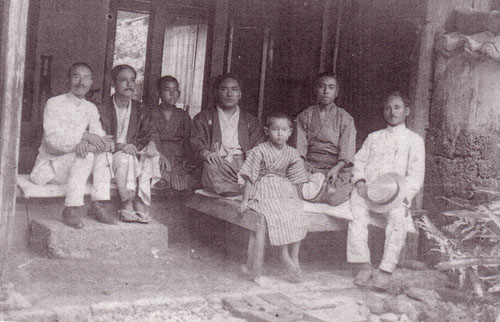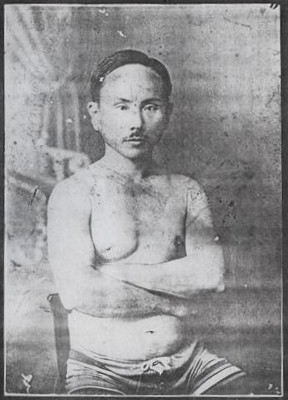I wrote this article shortly after my return from my 1 1/2 years martial practice and study tour on Okinawa.
![]() n 1906, Iha Fuyū bought a collection of Okinawan Puppet Theater songs from Funakoshi Gichin
n 1906, Iha Fuyū bought a collection of Okinawan Puppet Theater songs from Funakoshi Gichin
In Miyanaga Tōsō’s (1893-1964) book “The Okinawan Puppet Theater” of 1925, had been inserted a “Collection of Prose of Chondarā”. Chondarā is the old Okinawan name for the puppet shows performed at New Year’s Day as a blessing as well as for Buddhist prayer songs sung at the Bon Festival. This collection is considered a precious historical material as it reports of the state of affairs of a public entertainment arts which today is not in existence anymore.
The father of Okinawan studies, Iha Fuyū (1875-1947), noted on this collection in a chapter called “On the ‘Collection of Prose of Chondarā’”. There Iha states that according to Funakoshi Gichin, from whom he bought the collection around August 1906, the collection had originally been recorded by a person named Makaru Ani of the Okuma Klan from Gibo Dunchi.
In 1919, an exhibition of Miyagi family heirloom contains a photography showing Funakoshi Gichin, Majikina Anko, and Miyagi Sorin
In September 1919 the Kagoshima Shinbun newspaper printed an article called “Families of old Ryūkyū-Satsuma Friendship”. In it, Miyagi Sōrin, head of the Miyagi family of the time, introduced some of the family heirloom to the public. According to the article,
Miyagi Sōrin graduated from the Nagasaki Medical College and worked as a second-class drug seller at the time. He researched the families heirloom of old times and exhibits their genealogy, papers of the Resident Magistrate (of Satsuma in Ryūkyū), as well as a letter, a sword, tea ceremony utensils etc. they received from a Satsuma celebrity of the time. These were all put on display for public inspection.
Among the family heirloom was also the picture shown below, with Miyagi Sōron in the centre, historian Majikina Ankō (author of the Okinawa Issen-nen Shi) on the left, and Karate expert Funakoshi Gichin on the right.

In 1920, Funakoshi presents a photograph of himself to Sueyoshi Ankyo
In November 1922, Funakoshi published Ryūkyū Kenpō Karate, the first Karate book ever. The book cover was designed by Tochigi prefecture born painter Kosugi Hōan (1881-1964). The illustration of performances inside the book were drawn by Kosugi’s student Yamashiro Masatsuna.
Kosugi Hōan is most famous among Karate people as having been the designer of the Shōtōkan tiger. He traveled to Okinawa, arriving on February 2nd, 1916. In Naha Tsubogawa he rented the holiday house of Nakachi Iken which he used as a base for his vigorous travels all around various places until his departure on February 27th. On February 11th Kosugi visited the castle ruins of Nakagusuku, In those days, in order to travel there, he probably would have gone from Naha to Yonabaru by means of the narrow-gauge railroad operated by OkinawaPrefecture. From Yonabaru in direction of Awase he would have used theOkinawa horse-drawn buggy railroad track. Both services were terminated until the end of WWII. Afterwards Kosugi made a pilgrimage to Gosamaru’s gravesite, in the vicinity of which he draw a watercolor portrayal of two children he came in contact with. During his stay he wrote his “Records of an idle life in Ryūkyū“, and after WWII “Reminiscence on Ryūkyū”, the latter of which was published in the Tōkyō Shinbun. Returning home to the mainland, Kosugi had a welcome party together with Okinawan artist Yamada Shinzan (1885-1977). Also in 1916, Kosugi held an exhibit named “The Southern Islands”. 1918 he published “Japanese Style Woodblock Prints, 7th Collection: Ryūkyū”. For the June edition of Bungei Shunjū in 1930 he wrote “Karate-den”, an advertisement for Karate.
Funakoshi’s 1922 Karate book also contained forewords by (among others) Okinawa-born Imperial Japanese Navy Admiral Kanna Kenwa (pp. 1-4), the Bachelor of Arts Higaonna Kanjun (pp. 15-20), and the Haiku poet and journalist Sueyoshi Ankyō (pp. 22-25).
Sueyoshi Ankyō (1886-1924), aka Bakumondō, went to Tōkyōin 1905 for study and became a haiku poet and journalist. Following his return to his homeland Okinawa, he worked for the Okinawa Mainichi Shibun and Ryūkyū Shinpō newspapers and was responsible for the column on Haiku poetry. He also became editor-in-chief of the Okinawa Times newspaper. Together with Yamashiro Seichū (1884-1949) he revived the Okinawan poetry. He died on December 25th, 1924, at the age of 39.
The picture shown below was given by Funakoshi Gichin as a present to Sueyoshi Ankyō. The accompanying text reads: “photograph taken in early autumn 1920. Present to Sueyoshi Bakumondō“.

Source:
© 2012 – 2016, Andreas Quast. All rights reserved.
